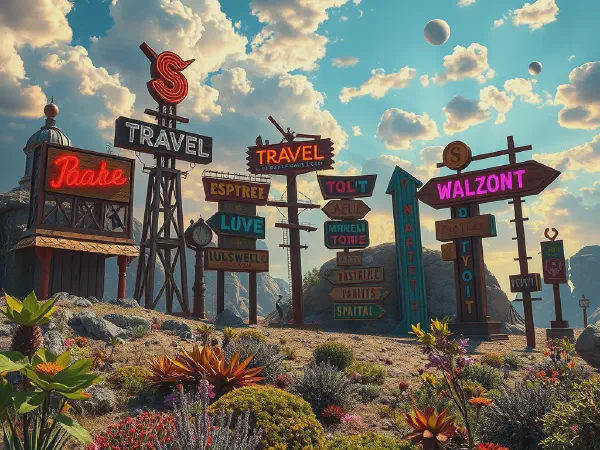Explore the World of Gigantic Signs: A Visual Journey

Gigantic Signs: The Power of Scale in Advertising and Communication
Gigantic signs have become a pivotal element in the realm of advertising and urban expression. These monumental displays not only capture attention but also convey messages that resonate with audiences on a grand scale. Whether it's an imposing billboard above a busy highway or a towering digital sign in a bustling urban center, gigantic signs dominate their surroundings and play a crucial role in branding and communication strategies.
In today's competitive market, businesses leverage gigantic signs to enhance visibility and create memorable impressions. The sheer size and innovative designs of these signs attract passersby, making them effective tools for advertisements. As a result, companies are increasingly investing in gigantic signs to stand out amongst competitors and forge a recognizable identity in their respective industries.
The impact of gigantic signs transcends mere marketing; they often become landmarks in their own right. Cities like Las Vegas and Times Square in New York are renowned for their oversized signs that draw tourists and locals alike. These towering structures serve not only as advertisements but also as cultural icons, weaving the fabric of urban experiences and contributing to local identity and tourism.
Furthermore, the technological advancements in sign design, including LED displays and digital screens, have revolutionized the use of gigantic signs. These innovations allow for dynamic content that can be updated in real-time, engaging audiences more effectively. Organizations are now able to personalize their messages, resulting in enhanced interaction and connectivity with their audience.
Despite their advantages, the design and maintenance of gigantic signs pose unique challenges that require careful consideration. Engineering, durability, and regulatory compliance are paramount to the successful implementation of these large-scale structures. Therefore, understanding the intricacies behind gigantic signs is essential for businesses looking to incorporate them into their marketing strategies.
Design Trends in Gigantic Signs
Innovative materials are at the forefront of designing gigantic signs, with a shift towards eco-friendly and sustainable options. Manufacturers are exploring the use of recycled materials, LED lighting, and energy-efficient technologies. These materials not only reduce environmental impact but also enhance the visual appeal and longevity of the signs.
Color psychology plays a critical role in the design of large signage. Colors evoke emotional responses and can significantly influence consumer behavior. Designers strategically use colors that align with brand identity while ensuring high visibility against countless urban backdrops, optimizing engagement and retention.
Typography choices are vital for maximum visibility in gigantic signs. Legible fonts that can be read from a distance are essential for effective communication. Designers are now integrating bold typefaces and innovative layouts that stand out against vibrant backgrounds, ensuring that messages are clear and impactful.
The integration of technology in sign design has led to a dynamic shift in how companies communicate with audiences. Digital signage, with its ability to display moving graphics and changing content, has become increasingly popular. This technology allows for real-time updates, boosting engagement, and providing businesses with a flexible advertising medium.
Impact of Gigantic Signs on Branding
Iconic gigantic signs have become synonymous with some of the world’s largest brands. For instance, the Coca-Cola sign in Times Square serves not only as an advertisement but also as a symbol of the brand's global identity. These signs build brand equity and recognition through their sheer scale and memorable designs.
Gigantic signs enhance brand recognition by creating a larger-than-life presence. A well-placed sign can penetrate the market more effectively, etching a brand in the minds of consumers. The visual impact of these signs often leads to increased consumer loyalty and a deeper connection to the brand.
The psychological effect of large signage on consumers is profound. Studies indicate that consumers gravitate towards recognizable brands, and the impressive scale of gigantic signs reinforces brand visibility and trust. The size of the sign often correlates to the perceived importance and reliability of the brand, making these signs a strategic tool for messaging.
When comparing conventional signage to gigantic signs, the effectiveness of larger displays is evident. Research shows that larger signs significantly boost recall rates and engagement levels compared to traditional signage, providing businesses with a powerful advantage in capturing consumer attention.
Construction and Maintenance of Gigantic Signs
Engineering challenges in gigantic sign construction are multifaceted, ranging from structural integrity to environmental resilience. Designers must take into account factors like wind resistance, weight distribution, and materials to ensure the safety and durability of these large structures.
Materials and durability considerations are critical in the construction of gigantic signs. The choice of weather-resistant materials, treated metals, and durable coatings can significantly influence a sign's lifespan. Ensuring that materials withstand various elements—such as rain, snow, and UV radiation—is crucial for long-term investment.
To ensure longevity, maintenance strategies for gigantic signs must be proactive and planned. Regular inspections, cleaning, and repairs are crucial to uphold the visual appeal and operational effectiveness of signs. Implementing consistent maintenance schedules can prevent costly overhauls and extend the life of these large displays.
Safety regulations for gigantic sign installations are strictly enforced across many jurisdictions. This includes compliance with zoning laws, assessing structural integrity, and ensuring that installations do not obstruct traffic or pose hazards. Adhering to these regulations is essential to mitigate risks and operate within legal frameworks.
Historical Evolution of Gigantic Signs
The origin and evolution of signage techniques can be traced back to ancient civilizations that used symbols and carvings to convey information. As societies progressed, so did the complexity and scale of signage, culminating in the gigantic signs we see today that dominate urban landscapes.
Noteworthy gigantic signs throughout history include the iconic Hollywood Sign, which has become synonymous with the film industry, and the towering Martinelli Building neon sign in São Paulo, which represents a significant landmark in Brazilian culture. These signs mark historical moments and reflect technological and artistic advancements in their respective eras.
The cultural significance of large signage cannot be understated. They have often represented evolution in communication, the rise of consumerism, and the essence of urban identity. Gigantic signs serve as beacons of cultural expression, illustrating the values and aspirations of societies over time.
Impact of technology on the evolution of signs has transformed how companies engage with consumers. The transition from static imagery to dynamic, interactive designs has made gigantic signs more relevant and appealing, enabling brands to adapt to modern consumer preferences and technological trends.
Gigantic Signs in Urban Landscapes
The role of gigantic signs in urban planning is significant, often influencing the character and identity of city spaces. City planners integrate these signs into their designs to enhance visual interest, drive foot traffic, and create appealing urban environments for both residents and tourists.
Gigantic signs have profound effects on city aesthetics. They can serve as focal points that imbue urban spaces with vibrancy and energy. Well-designed signs can elevate the overall look of a city, turning ordinary streets into extraordinary experiences, all while reflecting the unique character of the local community.
Tourist attractions featuring gigantic signs, such as the famous 'Welcome to Fabulous Las Vegas' sign, become cultural landmarks that draw visitors. These attractions not only enhance tourism but also contribute to local economies and promote cultural storytelling through their sheer presence and design.
Geographical considerations for sign placement play a crucial role in maximizing visibility and impact. Factors such as traffic patterns, sightlines, and surrounding architecture must be evaluated to ensure that gigantic signs effectively reach their intended audience and contribute positively to the urban landscape.
